

- Positive reinforcement: presentation of stimulus to strengthen response
- Negative reinforcement: removal of unpleasant or aversive stimulus to strengthen the response.
Punishment: An aversive consequence after a response, which diminishes the strength of that response
- Positive punishment: application of an aversive stimulus after a response
- Negative punishment: removal of attractive stimulus after a response
Teenage children : 10 to 19 years of age. New perspectives on adolescent motivated behavior: Attention and conditioning. Neural and Psychological Maturation of Decision-making in Adolescence and Young Adulthood. Adolescence is characterized by disproportionately increased risk-taking and novelty-seeking (Casey, Getz, & Galvan, 2008; Spear, 2000).
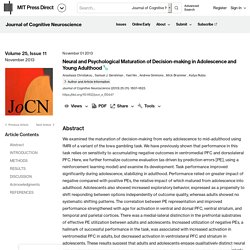
Current neurodevelopmental models suggest that this profile depends on a hyperactive reward system readily activating consummatory behaviors (Galvan, 2010), although there is evidence that a hypoactive reward system may instead be promoting the pursuit of disproportionately large motivating stimuli (Bjork et al., 2004; Spear, 2000). Substantial structural changes in the adolescent reward system affect dopaminergic (Teicher, Andersen, & Hostetter, 1995) and frontostriatal mechanisms (Galvan et al., 2006; Giedd et al., 1999; Sowell et al., 1999).
Reward-related decision-making has been studied widely with the Iowa gambling task (IGT; Bechara, Damasio, Damasio, & Anderson, 1994), a test of decision-making when faced with a mix of ambiguous positive and negative rewards. Frontostriatal development and probabilistic reinforcement learning during adolescence. Highlights This review summarizes current research on the neural mechanisms of adolescent learning.
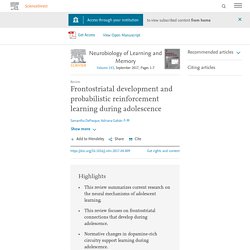
This review focuses on frontostriatal connections that develop during adolescence. Normative changes in dopamine-rich circuitry support learning during adolescence. Abstract Adolescence has traditionally been viewed as a period of vulnerability to increased risk-taking and adverse outcomes, which have been linked to neurobiological maturation of the frontostriatal reward system. Positive Reinforcement for Adolescents. By the time children have reached adolescence, their responses are often ingrained, but parental actions can still positively affect adolescent behavior. Since adolescents are struggling to develop their personal identity and are concerned about their body image, parental support is crucial to help positively frame experiences as learning opportunities. Positive reinforcement remains a powerful teaching tool during these formative years, and we encourage parents to take time to contemplate the ways they can help adolescents mature and become self-reliant.
Reinforce mature decisions by allowing increased privileges when adolescent demonstrates increased responsibility. For instance, an adolescent who consistently demonstrates the ability to come home at the requested time might be allowed a later curfew - whereas an adolescent who has not completed requested chores will not be allowed to leave home that evening.Express pleasure at positive adolescent behavior. The Computational Development of Reinforcement Learning during Adolescence. Citation: Palminteri S, Kilford EJ, Coricelli G, Blakemore S-J (2016) The Computational Development of Reinforcement Learning during Adolescence.
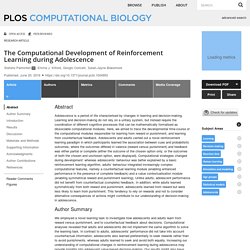
PLoS Comput Biol 12(6): e1004953. Editor: Jill X. O'Reilly, Oxford University, UNITED KINGDOM. Rewarding behavior is key to parenting teens, study suggests. Parenting is hard, and parenting teens brings about an entirely new set of challenges, from keeping their rooms clean to getting them home before curfew.

But, a new study suggests parents who want their teenagers to keep their grades up could have better success if they focus more on rewarding good behavior and less on threatening to punish the bad. According to the report, published in PLOS Computational Biology, British researchers have found that adolescents focus well on positive incentives, but have difficulty staying motivated to avoid penalties. Negative effects of positive reinforcement. SAGE Journals: Your gateway to world-class journal research. Adolescence is characterized by heightened reward sensitivity and risk-taking behaviors and often linked to high rates of drug use, reckless driving, and sexual promiscuity.
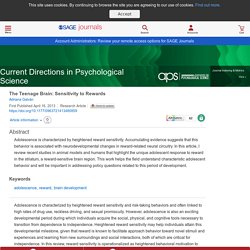
However, adolescence is also an exciting developmental period during which individuals acquire the social, physical, and cognitive tools necessary to transition from dependence to independence. Heightened reward sensitivity may help individuals attain this developmental milestone, given that reward is known to facilitate approach behavior toward novel stimuli and experiences and learning from new surroundings and social interactions, both of which are critical for independence. Reward-centricity and attenuated aversions: An adolescent phenotype emerging from studies in laboratory animals. Highlights Brain reward circuits and behaviors change similarly across species in adolescence.
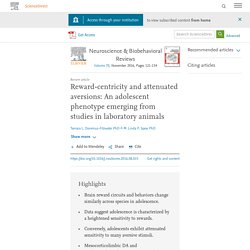
Data suggest adolescence is characterized by a heightened sensitivity to rewards. Conversely, adolescents exhibit attenuated sensitivity to many aversive stimuli. Mesocorticolimbic DA and endocannabinoid changes may contribute to these behaviors. Adolescent behaviors promote adaptive achievements, but also impart vulnerability. Parenting Teens: When It Comes To Learning, Positive Reinforcement Trumps Punishment. Teens generally aren’t afraid to defy authority.

Generations of parents know this, having tried different strategies for getting their adolescents to do what they ask — often in attempts to keep them safe and help pave a path toward success. Now, a new study shows that rewards, rather than punishments, could be the way to get them to cooperate. Researchers at the University College London asked 18 volunteers aged 12 to 17 and 20 volunteers aged 18 to 32 to complete both a learning task and post-learning task in which they chose between abstract symbols, each associated with a fixed chance of reward, punishment, or no outcome. As the trial progressed, participants learned which symbols were likely to lead to each result and adjusted their choices accordingly. Adults and teens alike proved equally capable of learning to be motivated by rewards, but the adults learned to avoid symbols associated with punishment while the adolescents did not.
Enhanced Striatal Sensitivity to Aversive Reinforcement in Adolescents versus Adults. Our goal in the current study was to focus on neural differences in the striatum, given its role in processing both positive and negative events (Levita et al., 2009; Jensen et al., 2003).
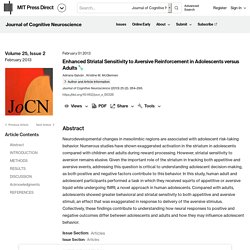
Physiological studies have shown that different neurons in the nucleus accumbens respond to both aversive and appetitive stimuli (Roitman, Wheeler, & Carelli, 2005; Wilson & Bowman, 2005; Setlow, Schoenbaum, & Gallagher, 2003; Yangimoto & Maeda, 2003). Specifically, elevated dopamine levels are observed in the accumbens in response to various aversive outcomes, including electric shocks, restraint stress, and anxiogenic drugs (Young, 2004; Kalivas & Duffy, 1995; Robinson, Becker, Young, Akil, & Castaneda, 1987). This region plays an important role in aversive conditioning and avoidance behavior in nonhuman animals (Hoebel, Avena, & Rada, 2007; Schwienbacher, Fendt, Richardson, & Schnitzler, 2004).
Developmental Changes in Learning: Computational Mechanisms and Social Influences. Risk-Taking Propensity in Older Adolescents: Internalizing Symptoms, Gender, and Negative Reinforcement. Objective: Engagement in risk behaviors, including substance use, risky sex, and violence, tends to increase throughout adolescence into young adulthood.

One motivational process that may underlie risk behaviors during adolescence is negative reinforcement. Moreover, gender and internalizing symptoms (e.g., depression and anxiety) may both convey risk for negative reinforcement-based risk taking. Along these lines, the aims of the current study were to (a) examine gender differences in negative reinforcement-based risk-taking propensity and (b) examine internalizing symptoms as a moderator of the relationship between gender and negative reinforcement-based risk-taking propensity.
Why Negative Reinforcement Works Better as Your Child Grows into A Teen. If you are someone who has always loved the freedom of “no strings attached”, the idea of marrying and having kids could be quite underwhelming.
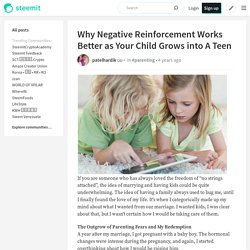
The idea of having a family always used to bug me, until I finally found the love of my life. It's when I categorically made up my mind about what I wanted from our marriage. I wanted kids, I was clear about that, but I wasn’t certain how I would be taking care of them. The Outgrow of Parenting Fears and My Redemption A year after my marriage, I got pregnant with a baby boy. The hormonal changes were intense during the pregnancy, and again, I started overthinking about how I would be raising him.
Use of harsh physical discipline and developmental outcomes in adolescence. StrausGKK1994CorporalPunishment. Physical punishment of children: lessons from 20 years of research. The Residue Effects of Parental Corporal Punishment on Young Adults’ Psychological Adjustment: Evidence From Malaysia - Chee-Huay Chong, Kee-Jiar Yeo, 2018. Introduction It has been debated for a long time on whether corporal punishment on children should be allowed or banned. With the awakening of various worldwide movements defending the rights of children, any form of violence in disciplining children is regarded as a violation of children’s fundamental rights to human dignity.
The United Nations Convention on the Rights of the Child (2007) has emphasized the elimination of all corporal punishment, however light, as well as all other cruel or degrading punishments. However, corporal punishment is still prevalent worldwide (Durrant & Ensom, 2012). When caning can turn into outright child abuse, Singapore News. Recently, a video of a couple hitting their daughter publicly in Jurong West with a cane and a tree branch went viral, prompting the mother to write to the media to apologise for her action.
She said her daughter had lied to her about homework and she "just exploded" as she could not believe that she had raised a liar. The video, posted two months ago, sparked a debate on whether caning is the best way to discipline children. TODAY. BEIJING — China has banned school teachers from meting out any punishment that can cause physical or mental trauma, after a string of student deaths linked to harsh discipline in recent years. New rules issued by the Ministry of Education that take effect Monday (March 1) forbid punishments at schools that humiliate students, as well as reinforcing the existing ban on corporal punishment.
Banned practices include caning, making students stand or kneel on the floor for hours and verbal abuse. Students are now encouraged to write an apology letter or do classroom chores for minor offences such as forgetting to do their homework. Those who commit more severe offences like bullying may be suspended or advised to undergo counselling.
Corporal punishment archaic, does more harm than good, Letters in Print News. I was surprised to read that 80 per cent of parents in Singapore still carry out corporal punishment and that schools are allowed to carry it out on male children, given the well-documented scientific evidence and studies on the detrimental effects and ineffectiveness of corporal punishment on children (Most parents here don't spare rod on kids at home: Study, July 30). In an updated policy statement on corporal punishment in November last year, the American Academy of Paediatrics noted mounting evidence that supported its call to ban physical discipline. It wrote: "Corporal punishment - or the use of spanking as a disciplinary tool - increases aggression in young children in the long run and is ineffective in teaching a child responsibility and self-control.
How to Reward Your Teen for Good Behavior. Behavior Modification to Help Your Child. 12 Examples of Positive Punishment & Negative Reinforcement. Adolescent learning: rewards, punishments, and the importance of context: BOLD. Parenting Children with Positive Reinforcement (Examples + Charts)